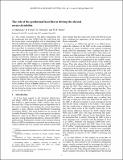The role of the geothermal heat flux in driving the abyssal ocean circulation
Author(s)
Mashayek, A.; Vettoretti, G.; Peltier, W. R.; Ferrari, Raffaele
DownloadFerrari_The role.pdf (2.405Mb)
PUBLISHER_POLICY
Publisher Policy
Article is made available in accordance with the publisher's policy and may be subject to US copyright law. Please refer to the publisher's site for terms of use.
Terms of use
Metadata
Show full item recordAbstract
The results presented in this paper demonstrate that the geothermal heat flux (GHF) from the solid Earth into the ocean plays a non-negligible role in determining both abyssal stratification and circulation strength. Based upon an ocean data set, we show that the map of upward heat flux at the ocean floor is consistent (within a factor of 2) with the ocean floor age-dependent map of GHF. The observed buoyancy flux above the ocean floor is consistent with previous suggestions that the GHF acts to erode the abyssal stratification and thereby enhances the strength of the abyssal circulation. Idealized numerical simulations are performed using a zonally averaged single-basin model which enables us to address the GHF impact as a function of the depth dependence of diapycnal diffusivity. We show that ignoring this vertical variation leads to an under-prediction of the influence of the GHF on the abyssal circulation. Independent of the diffusivity profile, introduction of the GHF in the model leads to steepening of the Southern Ocean isopycnals and to strengthening of the eddy-induced circulation and the Antarctic bottom water cell. The enhanced circulation ventilates the GHF derived heating to shallow depths, primarily in the Southern Ocean.
Date issued
2013-06Department
Massachusetts Institute of Technology. Department of Earth, Atmospheric, and Planetary SciencesJournal
Geophysical Research Letters
Publisher
American Geophysical Union (AGU)
Citation
Mashayek, A., R. Ferrari, G. Vettoretti, and W. R. Peltier. “The Role of the Geothermal Heat Flux in Driving the Abyssal Ocean Circulation.” Geophys. Res. Lett. 40, no. 12 (June 28, 2013): 3144–3149. Copyright © 2013 American Geophysical Union
Version: Final published version
ISSN
00948276